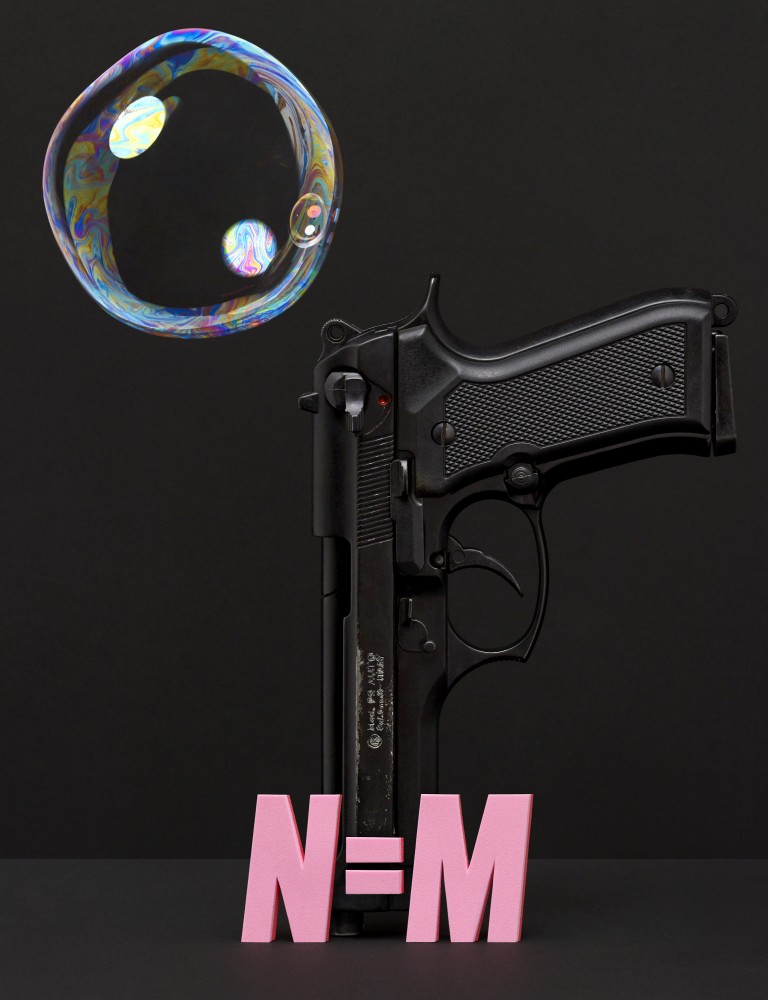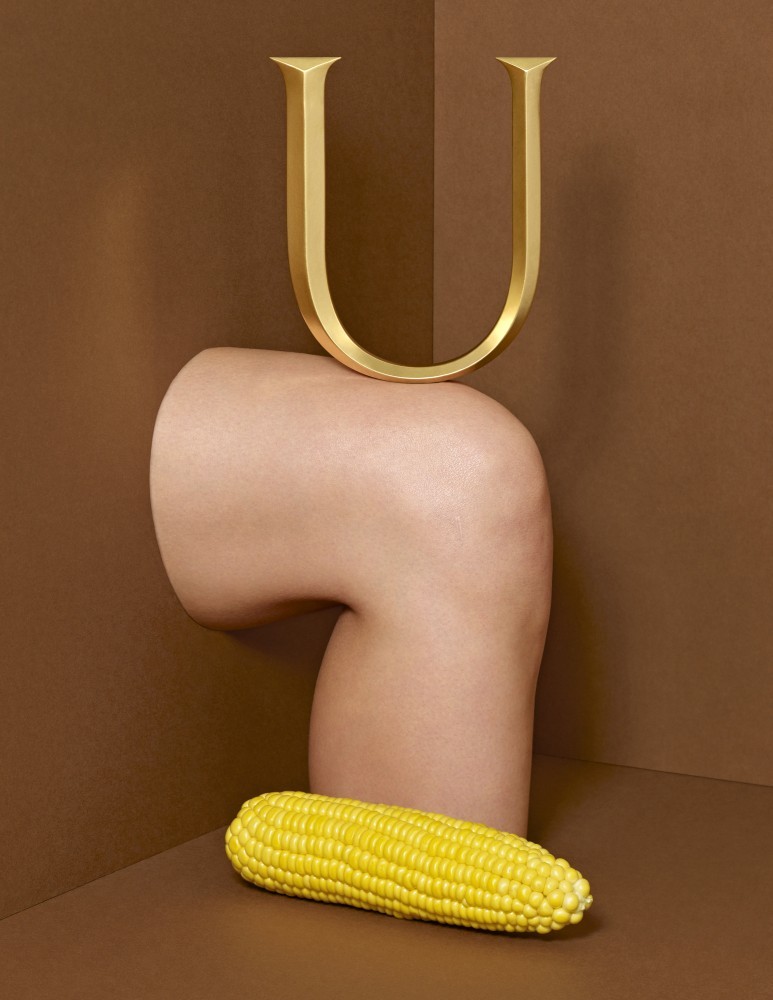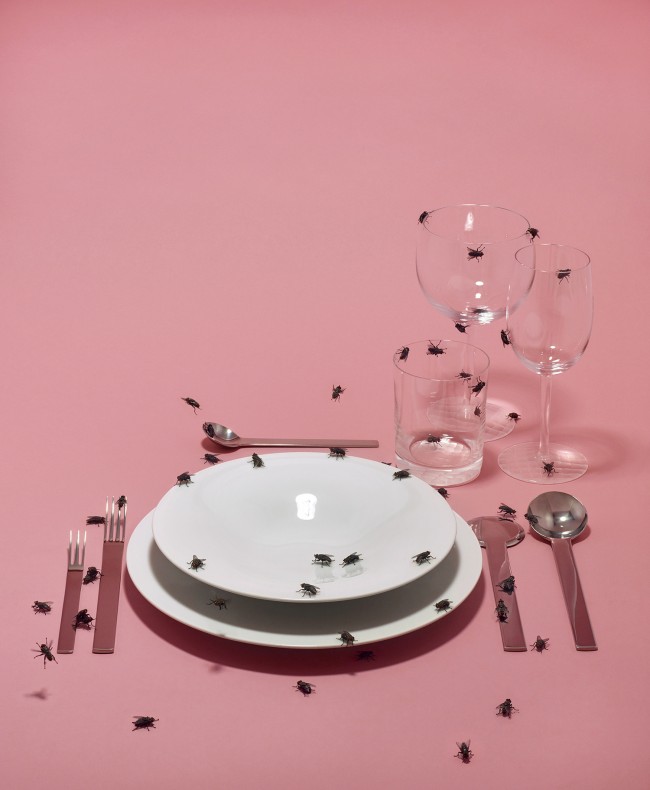REBUS PLAY: A Book Of Visual Puzzles By Artist Bela Borsodi
The photographer Bela Borsodi is based in New York, but his surrealist wit and dark sense of humor — think graphic images of a bone wearing a shoe or of anthropomorphic handbags in sunglasses strutting down a red carpet — are deeply indebted to the sensibilities of his native city Vienna. For his latest project Borsodi brings his signature flare for dark and sexy composition to rebus puzzles, a style of brainteaser that dates back to at least the Middle Ages. Borsodi’s lavishly printed new book Unicorn features 40 pages full of visual puns, per say, that use equations of pictures and letters to graphically spell out words. Counting the French illustrator Roland Topor among his inspiration, as well Barbra Streisand’s 1974 album cover Butterfly (a photo of a fly on a cube of unwrapped butter), Borsodi created visual semantic puzzles that rely on words within words, playfully using the differences between words’ sounds and spellings. The word “existence,” for example, is a picture of an ax, the letters “ist,” and a swarm of ants: AX + IST + ANTS = EXISTENCE. “Bubblegum” captures the colorful gleam of a delicate translucent bubble floating in the air beside a black pistol, then the legend for substitution N = M —BUBBLE + GUN (substitute N for M) = BUBBLEGUM. Get it? As is often the case with Borsodi’s work, the process is just as interesting as the images themselves, so PIN–UP called him up in his studio to provide the back story to five of the photographs from the book.

Bela Borsodi, Bubblegum, 2018. Courtesy of the artist.
I knew this image would only make sense if the photo was of a real pistol not of a toy. My first question was, “How do I get a real gun?” I didn’t have the money. So I had to find a real gun while listening on the radio about the Orlando massacre in the news. I went to see about renting a gun at this gun shop. It was very expensive to rent, about $600 an hour. I have a friend who has a gun, a real gun. But how was I going to get it home? There is no open or concealed carry in New York. So I had to transport it in a case like a doctor’s suitcase. I sat on the subway with this gun in this case. Someone came up to me and actually asked me, “What you have in your little case?” I answered, “just a gun.” Then when I got to my studio with the gun, I had to get the bubbles. I blew about 200,000 bubbles hoping one would make for a good picture.

Bela Borsodi, Existence, 2018. Courtesy of the artist.
This one was a stroke of genius for me. (Laughs.) I came up with it when I was in Italy. I wanted the letters to look handmade so I created the wooden “ist” myself that the ax chops into. Then my next challenge was how would I get both an ax and ants that were of the scale that I wanted? First I looked for toy axes. Boy scout axes were too big. On eBay I found only Playmobil axes. At some point I thought maybe I would have to make the ax myself. But then I found a miniature axe manufacturer in Thailand for action figures. Now I just needed the ants. I tried to order ants but the company I found was in North Carolina and they weren’t allowed to send the ants out of the state. I thought maybe I would have to fly to North Carolina and get 50 to 100 ants for $50. I couldn’t fly to North Carolina right away because it was right before Christmas. So my former assistant who now lives in North Carolina sent the ants to me to New York City by USPS. I love shooting ants. They’re very civilized and aesthetic. Afterwards I put them back in the container. And they die after two weeks without a queen.

Bela Borsodi, Unicorn, 2018. Courtesy of the artist.
This was one of the first ideas conceptualized. Unlike all the others, only one letter was needed. It’s an absurd, elegant composition. Because it is pushed into a corner I felt it “captures” the “unicorn.” I asked a friend if she would model the “knee” for me and then, one week before the shoot, she had a hit and run with an Uber, and had a broken leg for three months. She hurt her right knee, the one we needed for the shoot, so another friend of mine volunteered to let me shoot her knee. My favorite detail about the image in the end is the small scar on her knee. It was important that it was a woman’s leg. I think of a unicorn as a girl’s fantasy, so I thought it had to be a female-identified leg. The corn is real.

Bela Borsodi, Culture, 2018. Courtesy of the artist.
I own three human skulls, two are in New York, and one is in Vienna. My dad gave them to me when I was little — he was an an artist and often used to paint from them. When I was nine years old we went to the country in Austria, and he met with a monk, and he invited us to the beinhaus. When graves are dug up there to make room for new graves, the bones are given to the chapel and monastery. These are the bones of people who can’t afford to maintain their graves. We walked on bones. I was so intimate with my skulls. I brought them to New York in my luggage. If they had opened my suitcase at the airport and found two human skulls — and on top of that one of them has a hole of a gun shot — I’m sure it would have been problematic. The tire in the image is from a discount hardware store. It’s a tire for a lawnmower. I took this photo in the street, down by my house (in Lower Manhattan.) In order to avoid people calling the police upon seeing the set-up, I made a curtain around it; and I only took the curtain away during the moments when we took the shot. The letters in the image are made from wood, then painted. I attached them to the tire with a wire.

Bela Borsodi, Selfish, 2018. Courtesy of the artist.
For this one I wanted the whole composition to look very brutal, very full — the fish looks like a bag of money. First I was trying to find bells in a particular size, but that ended up being easy compared to finding the fish. I thought a severed fish head was more brutal than a full fish, so I was trying to find a fish head in Chinatown. I fell in love with Bonito, a giant fish — they must be three feet long. I totally underestimated how heavy it would be to carry this fish home, and then I had it in the kitchen and realized I had to decapitate this fish. I never realized how much blood there was in a fish. It sprayed everywhere. Fish blood smells really strange. It’s horrible! And it’s a very dark red. I put the head on an acrylic sheet. I had to put wires in the fish head so it would stay in place. It was dripping and it stank. I almost threw up. At first I thought I wanted to make a fish soup, but after it was over, I just threw the fish head away.
Text by Felix Burrichter with Whitney Mallett.
All photographs by Bela Borsodi.






